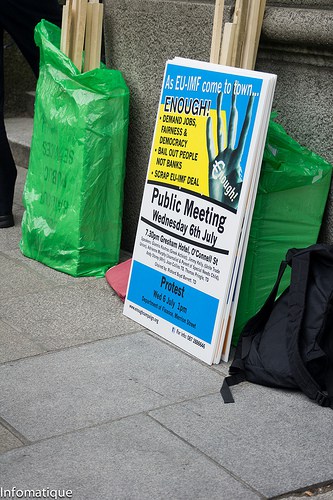This post represents the third installment of our special review section on Capital in the Twenty-First Century. First and second installments available here and here.
Piketty, Thomas. 2014. Capital in the Twenty-First Century. Harvard: Harvard University Press. 696 pp. Hc: $39.95. ISBN: 9780674430006.
Thomas Piketty’s 2014 Capital in the Twenty-First Century (translated from the 2013 French version) has clearly reinvigorated the debate about inequality, in particular in the Anglo-Saxon world. Prior to Piketty, many had already raised concerns about rising inequality, though the focus was largely on income from labour, with the highly remunerated CEOs as the lighting rod. Piketty equally shares these concerns, yet the contribution and buzz of his book comes predominantly from his longitudinal analysis of wealth inequality – gains from investments in stocks, land, property, etc., instead of income from labour. This is a much-needed contribution to the current debate, as wealth inequality tends to be even more skewed. Yet, it also comes with many challenges, as wealth is notoriously difficult to measure due to the variety of asset classes and the incentives and potential to hide wealth (in tax havens, for example).
The main argument set out in the book is that the return on capital grows faster than economic growth, which he formulates as follows: r > g. For the wealthy it suffices to (re)invest a fraction of the return on their capital to equal the growth rate. The remaining part they can consume (page 564). Judging from the media coverage of the wealthiest lavish lifestyles, their yachts and mansions, it appears plausible that the return on capital is higher than the economic growth – though, we would have to assume that these expenditures are paid for by their return on capital and not by income from labour. Notwithstanding his catchy formulation, Piketty insists that it relies on empirical data and that it is not just another economic formula that bears little resemblance to reality. With data covering more than two centuries of, among others, tax records (of France and the UK in particular), he nevertheless presents r > g more or less as a given in the case there are no political interventions – or world wars. It would result in an impossible state of endless accumulation. Maybe, then, he applies it as a warning: if we do not reverse the trend, we will eventually return to late nineteenth, early twentieth century rentier classes.
The future will tell to what extent Piketty’s analysis can withstand critical scrutiny, as his book has provoked fierce debate. Nonetheless, it offers an interesting analysis about the logic of inequality and provides us with an abundance of empirical data, even though Piketty is open about the fact that there remains a significant lack of adequate historical and contemporary data of, especially, wealth. Echoing Larry Summers, then, the book should be considered a (re)start of the debate rather than the end. In this review I shall address the relevance of Capital in the Twenty-First Century for social anthropology.
 The abundance of data and the complexity of the book are both a limiting factor, as one is bound to discover that certain aspects are not covered and/or nuances are missing, and an advantage, as one can easily choose one or two topics to elaborate on. For obvious reasons, namely the availability of data, it has a very strong West-European and US bias, so social anthropology may add a thing or two about economic inequality elsewhere in the world. Furthermore, and with reference to the general interests and methodologies of social anthropology, one of the book’s main limits is that apart from the characters featuring in novels by Jane Austen and Honoré de Balzac, inequality (and the politics involved) is hardly given a face. Piketty appears to be partly aware of this since he argues, ‘[t]he history of inequality is shaped by the way economic, social, and political actors view what is just and what is not, as well as by the relative power of those actors and the collective choices that result. It is the joint product of all relevant actors combined’ (page 20). Nevertheless, he hardly touches upon it, while, as has also be pointed out by Daron Acemoglu and James Robinson, enhancing inequality as well as reversing its growth is the product of actors operating in political and social contexts. Thus, for a more complete picture additional data on, and analyses of, the actors involved are needed.
The abundance of data and the complexity of the book are both a limiting factor, as one is bound to discover that certain aspects are not covered and/or nuances are missing, and an advantage, as one can easily choose one or two topics to elaborate on. For obvious reasons, namely the availability of data, it has a very strong West-European and US bias, so social anthropology may add a thing or two about economic inequality elsewhere in the world. Furthermore, and with reference to the general interests and methodologies of social anthropology, one of the book’s main limits is that apart from the characters featuring in novels by Jane Austen and Honoré de Balzac, inequality (and the politics involved) is hardly given a face. Piketty appears to be partly aware of this since he argues, ‘[t]he history of inequality is shaped by the way economic, social, and political actors view what is just and what is not, as well as by the relative power of those actors and the collective choices that result. It is the joint product of all relevant actors combined’ (page 20). Nevertheless, he hardly touches upon it, while, as has also be pointed out by Daron Acemoglu and James Robinson, enhancing inequality as well as reversing its growth is the product of actors operating in political and social contexts. Thus, for a more complete picture additional data on, and analyses of, the actors involved are needed.
Social anthropology’s contribution to the debates and analyses may also come from its ability to analyse the workings of perceptions. Inequality is not about economic calculations of differences in wealth and income only. It is predominantly about the (perceived) consequences of these differences. As Piketty says, ‘… there will always be a fundamentally subjective and psychological dimension to inequality, which inevitably gives rise to political conflict that no purportedly scientific analysis can alleviate’ (page 2). A closer look at how actors, poor, rich and in the middle, perceive inequality, its causes and consequences, and each other would be of essential value. Though not an anthropological study per se, I would be pleased to welcome a follow up on Elisa Reis and Mick Moore’s Elite Perceptions of Poverty and Inequality – in other words, what views do the rich have of the predicament of the poor?
But what I especially wish to convey is why social anthropology and other disciplines need to collaborate in critically engaging with one of Piketty’s main arguments – he actually states that ‘[t]he social sciences collectively know too little to waste time on foolish disciplinary squabbles’ (page 32/33). There should be a combined effort to address the raw realities of wealth accumulation and inheritance. According to Piketty, inheritance will become increasingly more important, with its ultimate result being the creation of new rentier classes – the explicit consequence when the return on capital is higher than economic growth. This feels counter-intuitive and at odds with dominant discourses of self-made man (and woman), successful start-ups, hedge fund managers and other well-remunerated professionals working long hours; despite that they seem a minority there are, of course, also prominent heirs among the super-rich.
Yet, according to Piketty inherited wealth represented roughly two-thirds of private capital in France in 2010, compared with barely one-third capital accumulated from savings (page 403). This is an astounding figure and if true in France and other societies, it indicates that if we want to more fully understand inequality (and the directions it may take) we do have to improve our knowledge of inherited wealth.

Firstly, the social sciences, including economics, have to join forces to improve the data on wealth and inheritance, i.e. amount of wealth, kind of assets, demographics of owners, tax(-evasion) infrastructures, cross-national differences, and, last but not least, whether it is an addition to, or substitute of, income from labour. Piketty, for one, seems to even express doubts about the return of the rentier classes as of old: ‘… we have moved from a society with a small number of very wealthy rentiers to one with a much larger number of less wealthy rentiers: a society of petits rentiers if you will’ (page 420). All the same, intergenerational wealth transfer may increasingly determine who is able to afford property (at a young age) and who can afford good education for his/her children – thus contributing to successfully landing a well-paid job, and therewith to the perpetuation of income from labour inequality. Many possessing the means to transfer wealth to their offspring may not share the super-rich’ large surpluses that inequality is associated with. They contribute to inequality nevertheless, but of a type that may be more difficult to pin down, is more widely shared and, as a result, more difficult to reverse.
Secondly, then, social anthropology should apply its skills to grasp the ‘everyday’ reality of inheritance and wealth accumulation – this has been largely absent since George E. Marcus’s work on dynastic families. Family wealth and inheritance are often not straightforward.
In the case of the French grandes familles, Michel Pinçon and Monique Pinçon-Charlot illustrate how their business practices are informed by ideas about how to safeguard the family wealth for future generations. Since, of course, heritage practices are not static it would be incredibly interesting and relevant to analyse how, for example, narratives change in the face of the debate Piketty has provoked. What levels of inequality (and tax evasion) are perceived as morally just? Everyone has a moral opinion about inequality, as few would nowadays accept that all the wealth be in the hands of only a very small number of people. Judging from Piketty’s work as well as from new data that may surface in the years to come, anthropologists should not limit themselves to the wealthiest only. How do petits rentiers, for example, justify their position? Since their wealth and everyday (working) lives do not reflect the morally-refuted past of solely living off rents – like Thorstein Veblen’s leisure class – they may not perceive themselves as part of the ‘problem’. By probing these and similar questions more systemically, social anthropology may help to better understand the current state of inequality.
Surely, Piketty’s book has its limits. But for those interested in (in)equality, it offers the potential to ask new questions, critically engage with its findings and stir the debate.
References:
Marcus, George E. 1983. Lives in Trust: The Fortunes of Dynastic Families in Late Twentieth Century America (Institutional Structures of Feeling). Boulder, CO: Westview Press
Pinçon, Michel and Monique Pinçon-Charlot. 1998. Grandes Fortunes : Dynasties Familiales et Formes de Richesse en France. Paris. Éditions Payot & Rivages.
Reis, Elisa and Mick Moore et al. 2005. Elite Perceptions of Poverty and Inequality. London and New York: Zed Books.
Veblen, Thorstein. 1994 [1899]. The Theory of Leisure Class. New York: Dover Publications.



